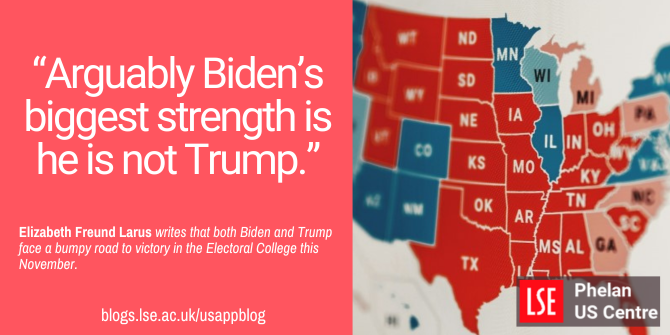 In six months’ time President Joe Biden will face former president Donald Trump in the 2024 election. As the candidates’ election campaigns continue to ramp up, Elizabeth Freund Larus looks at the apparent strengths and weaknesses of both contenders – who are now neck and neck in national polls – and outlines why Joe Biden might have an advantage in the Electoral College.
In six months’ time President Joe Biden will face former president Donald Trump in the 2024 election. As the candidates’ election campaigns continue to ramp up, Elizabeth Freund Larus looks at the apparent strengths and weaknesses of both contenders – who are now neck and neck in national polls – and outlines why Joe Biden might have an advantage in the Electoral College.
President Joe Biden and former President Donald Trump will face off on November 5 in a presidential contest for the second time in four years. This time, Biden is facing the headwinds of persistent inflation, massive flows of undocumented immigration, and concerns over what some have suggested is his own slowing mental acuity. Trump is facing legal headwinds, fighting several court cases that distract him from the campaign trail. Although Trump has made inroads in the minority vote since his 2016 and 2020 presidential campaigns, the Electoral College (EC) favors Biden to win. Trump needs an Electoral College fluke to retake the White House.
The Electoral College
The US presidential election is not a popularity contest. The founders of the American Republic wanted to avoid a situation in which a silver-tongued orator would persuade populations of the largest States to vote for them. If that were the case, US presidents would be elected only by the most populated states. Instead, they devised an Electoral College (EC) in which states both big and small have a say in electing the president. On Election Day, voters cast ballots for their preferred candidate’s Electors. There are 538 Electors, who are citizens selected by political parties in each State. Each State has the same number of Electors as it does Members in its Congressional delegation: one for each Member in the House of Representatives plus two Senators. The District of Columbia is allocated three Electors. (See Figure 1.) A candidate must win 270 EC votes to be elected president.
Figure 1 – Number of Electoral College Votes by State

Source: https://www.270towin.com/
Most states have a “winner-take-all” system that awards all Electors to the presidential candidate who wins a particular state’s popular vote. (Maine and Nebraska each have a variation of “proportional representation” where Electoral Votes are allocated according to Congressional Districts won) This “first-past-the-post” (FPTP) electoral system favors competition between two major parties because, unlike proportional representation systems, there is no prize for second or third place. Third party candidates nevertheless run to try to influence policy. The 2024 third party candidates are attorney Robert Kennedy Jr., an independent candidate; physician Jill Stein of the Green Party; and socialist academic Cornel West from the Justice for All Party. None are polling at double digit figures.
The 2024 Electoral Map
Following his wins in the Super Tuesday and Ohio presidential primaries in March, Trump became the presumptive Republican nominee, setting up a rematch with Biden. The two men are polling neck and neck. An average of national polls shows Trump with a 0.2-point lead over Biden (45.6 versus 45.4) in a two-way race, and a one percent lead in a five-way race. While these early polls are hardly indicative of the Election Day results, Trump’s support currently exceeds that of his previous races. In mid-April 2020 Biden had a 5.5-point lead over Trump; in mid-April 2016, Hillary Clinton had a 9.9-point lead over Trump.
The most significant change since Trump’s 2016 and 2020 contests is his gains with the minority vote. Trump has picked up support from Black Americans and Hispanics since 2016 and 2020. In the swing states of Arizona, Georgia, Michigan, Nevada, Pennsylvania, and Wisconsin, 22 percent of Black people and 42 percent of Hispanics said they would vote for Trump. Their major grievance is the economy. Forty-eight percent of Black Americans and 50 percent of Hispanics polled in the Battleground States indicated that U.S. economic conditions are poor. Fifty-eight percent of Hispanics and 31 percent of Black people in Battleground States indicated that they trusted Trump more than Biden to do a better job on the economy.

Photo by Clay Banks on Unsplash
Most US States are predictably Democrat or Republican leaning, with Trump likely to win the “red” States and Biden the “blue” States and the District of Columbia. In Biden’s favor, two of the States with the most EC votes – California and New York – are “blue” netting 83 EC votes. The next two biggest States in terms of EC votes are “red” Texas and Florida, which net 68 EC votes. With the outcome in the “blue” and “red” States predetermined, the key to victory in 2024 is success in the Battleground States, where a total of 93 EC votes are up for grabs.
In recent polls, Trump is leading Biden in six of the seven Battleground states. In Arizona, Trump is leading by 4.9 points, Georgia 3.8 points, Michigan 2.8 points, Nevada 3.2 points, North Carolina 4.0 points, and Wisconsin 0.6 points. Biden is ahead in Pennsylvania by 0.1 points. In 2016, Trump carried them all, except for Nevada. In 2020, Trump won North Carolina by 1.34 points, but Biden carried the other six by 0.23-2.78 points. Of these Battleground States, Biden needs 45 EC votes and Trump needs 51. Reaching either target means winning three of the Battleground States. Trump won in Pennsylvania in 2016 but lost there in 2020. Trump must win Pennsylvania to be elected in 2024. Even the smallest of margins make a difference in the election. In 2020, Biden beat Trump 49.6 percent to 48.9 percent, a difference of only 0.7 percent. In 2016, Trump defeated Clinton 47.2 percent to 46.5 percent, a difference of 0.7 percent. This is where Robbert Kennedy Jr.’s third-party candidacy is significant. Kennedy has zero chance of being elected president but can take votes away from either Biden or Trump. Kennedy garnered nine percent of the vote in recent polls, enough to make a difference in the Battleground States.
Biden and Trump’s strengths and weaknesses
Arguably Biden’s biggest strength is he is not Trump. Biden was elected largely because he appeared to be the candidate best able to bring normalcy back to the US presidency following Trump’s term in office. Perhaps his biggest advantage in the 2024 contest is an Electoral College that favors his reelection. Biden can count on 226 EC votes from reliably Democrat States, some of which are the US’ most populous. Another strength is Biden’s large War Chest which stood at $192 million in early April. Biden’s campaign has outraised Trump 2:1. Biden enjoys support from high roller donors, media influencers and Hollywood entertainers like Taylor Swift, and former US presidents Bill Clinton and Barack Obama.
Biden’s weaknesses are persistent with concerns over high inflation, immigration at the US Southern border, and what some perceive to be his declining mental acuity. Biden never participates in press conferences and all his speeches are scripted. Inflation, which appeared to be easing, headed north again in the first quarter of 2024, compelling the US Federal Reserve to delay plans to reduce interest rates. Oil and gas prices are increasing, hitting American families in the pocketbook. These factors may be feeding into Biden’s unfavorability rating of 55 percent, which far exceeds his favorability rating of 42.5 percent. Another problem for Biden is an enthusiasm gap. Many Biden supporters lack enthusiasm and might not vote on Election Day. In the Battleground State of Michigan, Arab Americans who are angry with Biden for his support of Israel in the conflict in Gaza might not show up to vote on Election Day.
Trump’s greatest strengths are perceptions of his economic record and enthusiasm among supporters. MAGA supporters will support Trump no matter what, and many want vindication after Trump’s defeat in 2020 in what they believe was a stolen election. Trump’s numerous court cases are his greatest weakness. He is appealing a property fraud case and is fighting a falsifying records case in Manhattan, fighting an election interference case in Georgia, and is awaiting trial into his handling of sensitive material in Florida. A criminal case on January 6 violence at the US Capitol has been suspended indefinitely. The cases have failed to stop Trump’s momentum, however, and appear to have strengthened his candidacy: they have given him millions of dollars in free publicity and have given Trump a bump in the polls.
The Magic Number 270
There is still time for an October surprise, in which an unanticipated event adversely affects one or both campaigns. If that happens and voters withdraw support from Biden and Trump, Kennedy might gain enough Electoral College votes to deprive the top contenders of the majority 270 required by the US Constitution to win. In that case, the presidential election would be thrown to the House of Representatives (choosing from the three candidates who received the most EC votes) where votes are determined by state delegations rather than individual members of the House. Because states with Republican controlled delegations (28) outnumber those with a Democratic delegation (22), the House would likely elect Trump president. The Senate then would select the vice president. The Senate must choose between the top two EC vote recipients. In this case, the Senate could elect Joe Biden vice president.
- Please read our comments policy before commenting.
- Note: This article gives the views of the author, and not the position of USAPP – American Politics and Policy, nor of the London School of Economics.
- Shortened URL for this post: https://wp.me/p3I2YF-dMN






